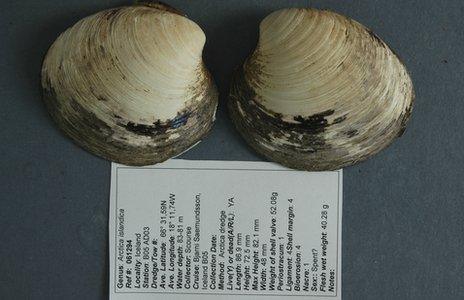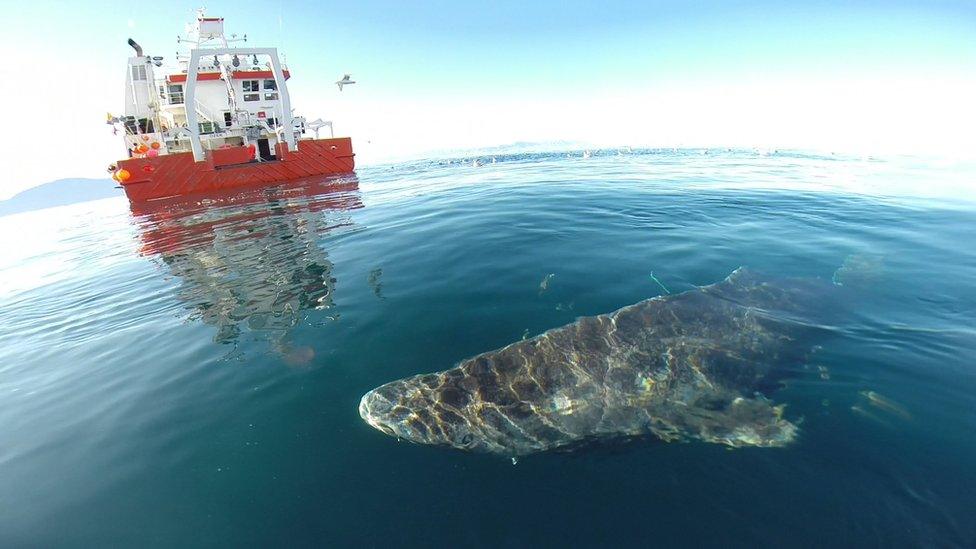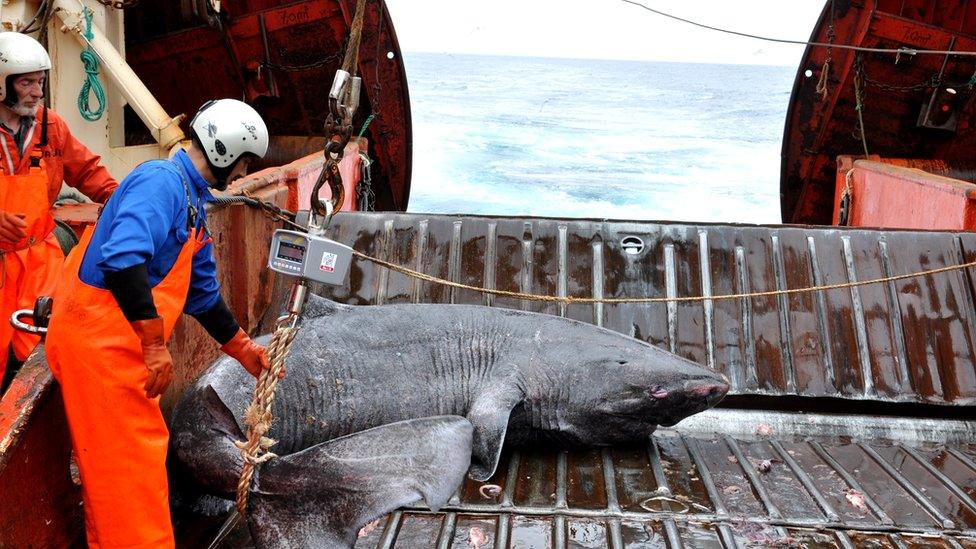Ming, the 500-year-old clam, was an ocean quahog clam (Arctica islandica) that lived off the coast of Iceland and was determined to be 507 years old when it was captured in 2006. It is known as the oldest individual non-colonial animal ever discovered, with its age calculated by counting growth rings in its shell.
Unfortunately they opened the clam to count the rings to determine the age and thereby killed the oldest animal on Earth; so the story goes
Clam-gate: The epic saga of Ming
- Published
14 November 2013
Share
Image caption,
Ming the clam reached the age of 507
Rebecca Morelle
Science reporter, BBC World Service
The discovery that a clam called Ming reached the age of 507 has made headlines around the world.
As has the news that the scientists behind the find accidentally killed the poor old (very old) bivalve in the process of trying to work out its age.
It's an epic shellfish saga, with all the makings of a rather tasty story.
But dig a little deeper, and there's more lurking beneath the shell of this morsel of news.
"We've had emails accusing us of being clam murderers," laments Prof James Scourse from Bangor University in Wales.
Various other reports suggested that the team has bungled its research.
But that's not the case, Prof Scourse tells BBC News.
Clamity
Ming the clam - so called because it hails from the age of the Chinese dynasty - was first found in 2006 during an expedition to Iceland.
The Bangor University team was interested in studying these animals, called ocean quahogs
(Arctica islandica), for a couple of reasons.
Firstly, because these clams are known for their longevity, and could provide clues about the science of ageing.
And secondly, they can tell us about the history of the oceans.
With each year, they add a new ring to their shell, and analysing these can provide information about changes in the oceans and the climate during their lifespan.
But to do this, sections of their shell need to be taken and studied. And once the clam is opened, it dies, explained Prof Scourse.
At first there was nothing to suggest that Ming was any different to the other clams collected.
But in 2007, an initial count of the rings in its shell suggested the bivalve
was a record-breaking 405-410 years old, external.
And now the elderly clam has made the headlines again, because a new more detailed analysis suggests it had lived for more than half a millennium.
The Bangor team says the notion that they knew in advance that it was the longest-lived species and then deliberately destroyed it is incorrect.
Instead, the researchers say Ming was part of a wider study, and just turned out to be very old.
They add: "The same species of clam are caught commercially and eaten daily; anyone who has eaten clam chowder in New England has probably eaten flesh from this species, many of which are likely several hundred years old."
Others, against consuming creatures or using them for science, might disagree about the merits of using the clams in this way.
These creatures are also threatened by dredging and ocean acidification.
But while Ming has captured the world's attention, it might not be a one off.
Scientists believe there is a high probability that there are ocean quahogs that are even more ancient lurking beneath the sea bed.
And while we're talking about ancient arctic species that live 100s of years, we must include the Greenland shark which has to be "putrefied" prior to eating, since it basically has antifreeze circulating in it to survive the arctic water temperatures...
400-year-old Greenland shark ‘longest-living vertebrate’
12 August 2016
Greenland sharks are now the longest-living vertebrates known on Earth, scientists say.
Researchers used radiocarbon dating to determine the ages of 28 of the animals, and estimated that one female was about 400 years old.
The team found that the sharks grow at just 1cm a year, and reach sexual maturity at about the age of 150.
The
research is published, external in the journal Science.
Lead author Julius Nielsen, a marine biologist from the
University of Copenhagen, external, said: "We had our expectations that we were dealing with an unusual animal, but I think everyone doing this research was very surprised to learn the sharks were as old as they were."
The former vertebrate record-holder was a bowhead whale estimated to be 211 years old.
But if invertebrates are brought into the longevity competition, a
507-year-old clam called Ming, external holds the title of most aged animal.
Slow swimmers
Greenland sharks are huge beasts, that can grow up to 5m in length.
They can be found, swimming slowly, throughout the cold, deep waters of the North Atlantic.
With this leisurely pace of life and sluggish growth rate, the sharks were thought to live for a long time. But until now, determining any ages was difficult.
For some fish, scientists are able to examine ear bones called otoliths, which when sectioned, show a pattern of concentric rings that scientists can count as they would the rings in a tree.
Sharks are harder, but some species, such as the Great White, have calcified tissue that grows in layers on their back bones, that can also be used to age the animals.
"But the Greenland shark is a very, very soft shark - it has no hard body parts where growth layers are deposited. So it was believed that the age could not be investigated," Mr Nielsen told the BBC.
However the team found a clever way of working out the age.
Image source,Julius Nielsen
A Greenland shark after its release from the research ship
"The Greenland shark's eye lens is composed of a specialised material - and it contains proteins that are metabolically inert," explained Mr Neilson.
"Which means after the proteins have been synthesised in the body, they are not renewed any more. So we can isolate the tissue that formed when the shark was a pup, and do radiocarbon dating."
The team looked at 28 sharks, most of which had died after being caught in fishing nets as by-catch.
Using this technique, they established that the largest shark - a 5m-long female - was extremely ancient.
Because radiocarbon dating does not produce exact dates, they believe that she could have been as "young" as 272 or as old as 512. But she was most likely somewhere in the middle, so about 400 years old.
It means she was born between the years of 1501 and 1744, but her most likely date of birth was in the 17th century.
"Even with the lowest part of this uncertainty, 272 years, even if that is the maximum age, it should still be considered the longest-living vertebrate," said Mr Nielsen.
Conversely, if her age is at the upper end of the scale, she will have out-lived Ming the clam - although her age has a greater probability of lying in the middle.
Conservation lessons
The team believes the animals only reach sexual maturity when they are 4m-long. And with this new, very lengthy age-range, it suggests this does not occur until the animals are about 150 years old.
The researchers say this has consequences for future conservation of the animals.
Image source,Julius Nielsen
A Greenland shark caught as by-catch
Because of their extreme longevity, Greenland sharks may still be recovering from being over-fished before WW2.
The sharks' livers were once used for machine oil, and they were killed in great numbers before a synthetic alternative was found and the demand fell.
"When you evaluate the size distribution all over the North Atlantic, it is quite rare that you see sexually mature females, and quite rare that you find newborn pups or juveniles," Mr Nielsen explained.
"It seems most are sub-adults. That makes sense: if you have had this very high fishing pressure, all the old animals - they are not there any more. And there are not that many to give birth to new ones.
"There is, though, still a very large amount of 'teenagers', but it will take another 100 years for them to become sexually active."
Another author of the study, Prof Christopher Ramsey, director of Oxford Radiocarbon Accelerator Unit at the
University of Oxford, external, said that radiocarbon dating could be used to determine the ages of other animals, but was not likely to be chosen as the primary method.
"For many animals we have other methods to determine age," he said.
"Also, the radiocarbon method is not very precise, and so is only really relevant for very long-lived species."
He added that the statistical method used to determine the sharks' ages was Bayesian statistics.
"Bayesian statistics were first worked out by the Rev Bayes in the 18th Century. This means he will have been working on this when some of these oldest sharks were young."




